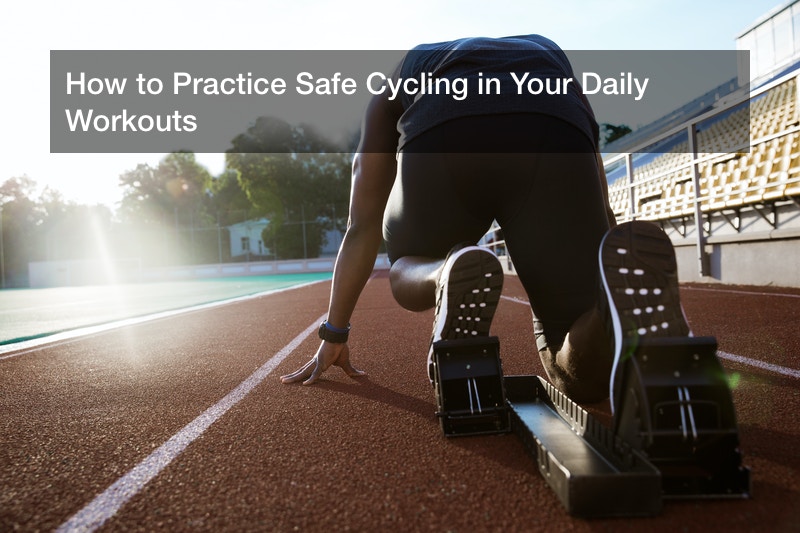
Cycling has been an increasingly popular way to travel and exercise across the world. Many cities are taking measures to become more cycling-friendly to encourage people to try cycling as a mode of transportation because it is cost-efficient, environmentally friendly, and a great way to get exercise. Although cycling has many benefits, there are also certain risks you take when you choose to cycle to run errands, go to work, or exercise. Whether you are a seasoned bicycler or deciding to take up a new exercise hobby, it is important to practice safe cycling habits. Cycling injury prevention is one of the most essential things to learn before you start cycling.
1. Be Cautious of Vehicle Errors

Although cycling can be an amazingly fun way to get exercise, there is always a risk when cycling around others. If you choose to cycle on roads, particularly, you must be aware of the vehicles around you. While it is the driver’s responsibility to yield to the cyclist, sometimes it is difficult for them to see a cyclist or they may have trouble perceiving a safe distance from the cyclist. To avoid accidents, you must always be cautious and prepared for a driver’s error.
Drivers can sometimes turn into the path of a cyclist because they perceive a great enough distance for the cyclist to slow down and allow the vehicle to turn when sometimes this isn’t the case. This can send the bicycler crashing into the vehicle and onto the hard asphalt. Drivers can also sometimes fail to see bicycles when changing lanes and not give the cyclist enough time to change their speed, resulting in accidents. Although there is a limit to the ways that a cyclist can prepare for driver error, it is important for cycling injury prevention for cyclists to always be focused and aware of their surroundings to be able to react quickly.
In addition to being prepared for vehicle errors, there are certain responsibilities a cyclist must follow in order to promote the safety of themselves and traffic around them. First, you must always follow the flow of traffic. Riding against the flow of traffic is actually illegal because it increases the risk to both motorists and cyclists who are not prepared to look out for a cyclist going against the flow of traffic. Cycling injury prevention relies greatly on the knowledge and rule-following skills of the cyclist. Also, it is important to use hand signals when making turns. Not only is this a good courtesy to use to alert motorists and other cyclists, but it can also help vehicles behind you prepare to slow down as you make your turn. However, you should also make sure to look out for any bumps or potholes before you remove your hand from your handlebars to make sure your bike does not lose control.
Sometimes cycling injury prevention doesn’t work. If you find yourself in a cycling accident with a vehicle, it might be time to contact a bicycle accident attorney. It is the responsibility of a vehicle to yield to pedestrians and cyclists so it is commonly the fault of the driver when involved in an accident with a cyclist. However, the help of an attorney is essential when making your case.
It is important to realize the seriousness of vehicle-bicycle collisions. Although many cyclists walk away from accidents with scrapes and bruises, sometimes the outcomes are much worse. Between 2016 and 2018, 455 cyclists were killed in traffic incidents. Accidents with cyclists involving vehicles often result in broken bones, cuts and abrasions, and head injuries. Many cyclists with head injuries often must seek a brain injury attorney in order to pursue monetary compensation to pay for astronomical medical bills. When choosing to cycle in traffic, the bicycler must be aware of the risks.
2. Practice Safety on Uneven Paths

Although many cyclists prefer concrete paths in more urban areas, some cyclists prefer the challenge and excitement of dirt trails. When choosing to bike on an uneven surface, a large part of cycling injury prevention is to always exercise the appropriate caution on dirt trails. Cyclists are encouraged to do research before choosing an off-road trail to ensure that the bike they are using is appropriate for the level of difficulty of the trail. In addition, the level of experience of the bicycler should be considered. If you have never biked on an off-road trail before, make sure you aren’t choosing a trail that has a high level of difficulty. Often, park websites provide information about the biking trails so you know what to expect.
When cycling on trails, always make sure to keep an eye out for other cyclists and hikers. Cycling injury prevention often relies on verbal communication to let hikers and cyclists know that they are behind them. It is also essential to let the hiker or cyclist know if there are more cyclists behind you or if it is just you. Using these communications will help others on the trail give you the space you need and help to avoid a collision which might land you in urgent care with stitches!
Some of the trails that you choose to travel might have certain obstacles in your way like tree roots, rocks, and streams. Always make sure that you use caution if you haven’t experienced obstacles like this before. Cycling injury prevention requires you to be aware of your own limits. Remember, when in doubt, walk it out! Don’t try to tackle these obstacles quickly by riding around or over them if you aren’t completely confident. It is better to hop off the bike and walk your bike around the obstacles than risk falling off. Many cyclists who fall off their bike at a high speed risk injuries to the teeth that will send them to a dentist for emergency dental care. Restorative dentistry can cost thousands of dollars, which could be avoided if you simply use caution on uneven trails!
3. Check Your Equipment

One commonly forgotten safety measure in cycling injury prevention is checking your bike for potential hazards. Every time you choose to cycle, you must first check a number of things on your bike for safety. First, you should check the tire pressure on your bike. Bicycle tires should be firm and full of air, as flat tires can cause you to lose control of your bike as you travel. Road tires should be between 80 to 130 psi, while mountain tires should be between 25 to 35 psi. Consider that the more you weigh, the higher your tire pressure should be. However, you should never exceed the manufacturer’s listed psi levels. The bike manufacturer’s tire pressures should be listed on the inside of your tire as well. Your tire pressure should be checked at the minimum of once a week for ideal safety measures.
In addition to tire pressure, your bike chain should also be checked. A broken bike chain will stop the bike from working, but sometimes a chain might need to be serviced first to prevent it from breaking during a ride. Chains get worn with frequent use, and it is important to make sure you replace a worn chain before it breaks to avoid potential accidents and injuries. Worn chains can cause problems with shifting your bike, which can cause wear and damage to other parts of your bike such as the cassette. To check your chain, you can lift it off the chainring. If there is a large gap between the chainring and the chain, your chain is probably stretched out and in need of replacement.
Another thing you should check before biking is your brakes. This is perhaps one of the most important things to check before going on a bike ride because without working brakes, collisions are likely to occur. To check your brakes, you should walk your bike to a flat surface and pump the brakes. If the stop doesn’t feel firm, your brake pads might need replacing. It is essential that your brakes are fully effective before going on a bike ride. Do not attempt to go on a bike ride if your brakes feel “off” or as if they are going to fail.
4. Use the Appropriate Attire

Many people don’t consider that the things you wear while biking directly impact your safety. You can often tell an experienced cyclist from a novice just by the clothing they choose to wear. If you are going on a leisurely neighborhood bike ride, you may not need to pay as much attention to what you are wearing, but if you’re biking for the purpose of exercise you should consider dressing for safety.
Regardless of your intent of biking, however, absolutely everyone should wear a helmet. According to recent studies, only 12% of injured cyclists under 17 were wearing a helmet. Many bicycle-related injuries and deaths could be avoided or lessened if helmets were worn. When picking a helmet, make sure you are finding one that fits correctly and is adequate for your intended use. A helmet should fit to be one inch or less above your eyebrows to protect your forehead. Also, if you are mostly road biking, consider getting a brightly colored helmet to let motorists see you from far away.
Another way you can increase your safety while cycling is to wear brightly colored, close-fitting clothing. Bright colors will help other cyclists or motorists see you from far away. In addition, close-fitting clothing will prevent you from getting clothing stuck in the spokes of your bike and causing an accident. If you are biking mostly at dusk or night, consider getting flashing lights to attach to your bike wheels as well as reflecting strips to attach to your bike or backpack.
Finally, make sure you are choosing the appropriate footwear for a bike ride. You should never wear flip flops when riding a bike. Your shoes should ideally be close-toed and flat-soled. If they have anything that dangles, you shouldn’t wear them at risk of getting stuck in the spokes. Poorly fitting shoes may also fall off when bike riding, so make sure that they fit snugly. Also, make sure that your laces are tied tightly and tucked in when riding a bike.
5. Practice Workout Safety

Making sure to practice workout safety is an important part of cycling injury prevention. Cyclists can often start biking on a long trail without preparation and increase their risk of injury. Always consider safety when choosing the intensity of your workout. Although experts recommend adjusting your workout every 2 to 5 weeks to increase effectiveness, make sure that you aren’t choosing a trail or trip length that is too much for you to complete. Sometimes, a cyclist will become exerted and be unable to complete a trail, risking getting stuck in the woods without help nearby.
For cycling injury prevention, it is important to think ahead. It is recommended for cyclists to bring a small, lightweight backpack full of useful items. Water is an essential, as dehydration can cause muscle cramps and dizziness, which can make cycling incredibly dangerous. Small snacks can also be helpful to bring in case you experience a breakdown or if you need a little bit of energy for your trip. A small first aid kit with antiseptic, band-aids, and blister pads can also be useful. Experts recommend always carrying a medical bracelet or some form of identification which will help EMS staff if you are unable to answer their questions or unconscious.
Using these tips may not prevent every cycling catastrophe, but it is certain to help. Remember that when cycling, prevention is key. Is it far easier to prevent an accident than to recover from one. Communication with other cyclists and motorists is also incredibly helpful when practicing bike safety. Sometimes, injuries and accidents will happen, but if you take proper precautions beforehand the likelihood will be lessened.



